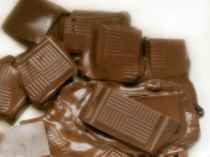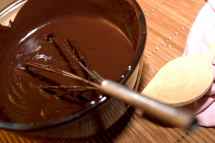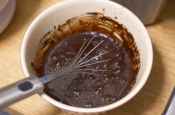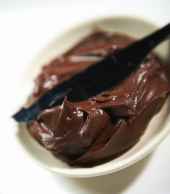Cooking tips for melting chocolate - ideas and equipment for best results.

The following melting methods explain how to melt chocolate without burning or spoiling the flavour of your favourite recipes.
The two most important things to remember when you are melting chocolate are firstly to use gentle heat carefully, and secondly, to avoid water, as both of these can spoil it and thereby spoil your recipe.
1. If over-heated, or heated too quickly - it will burn.
2. It also reacts very badly with water and will "sieze", that is - it will go lumpy.
With that in mind, all equipment used for melting must be dry; for example do not cover the bowl when using the double pan method for melting as described below - in case any condensation should form on the lid and drip down, or even any steam come into contact with the chocolate you are melting.
Dark should not be heated above 50C, 120F. Milk and white should not be heated above 45C, 110F. Go to this page for explanations on the various kinds of chocolate products available for you to use.

Although it is the method most often described for melting, the double pan method is certainly not the only one.
I think using a heat-proof bowl in a very low oven is the best method; but I will go through the other options available to you - it may be worth trying different methods to see which works best for you.
The double pan method is where a heat-proof bowl is placed over a saucepan of simmering water, not boiling. This is tricky, but as long as you remember the golden rules, you should have no problems.

Double pan method
If you don't own a double pan, or bain-marie, then a bowl and saucepan will suffice: break or chop the chocolate into roughly equal pieces and place in a heatproof bowl. Place the bowl in a saucepan containing hot water. A glass bowl is best so you can keep an eye on the simmering water below.
It is important for the water in the glass bowl to only barely simmer.
Do not let the water boil, or let any water - or steam, come into contact with the bowl.
The reason is that chocolate reacts or "seizes". It is then unusable, as it goes lumpy, or even into a solid mass. You can try and recover the situation by adding vegetable oil, but it's not ideal and best avoided in the first place.
So make sure the bowl fits snugly over the pan, so that no steam can escape round the sides. Also, make sure that the bottom of the bowl does not touch the hot water below. As it melts, stir gently with a wooden spoon or spatula so it melts evenly and thoroughly.
When melted, remove from the heat, and gently stir to make sure that any unmelted gets melted and is smooth and creamy. Do not overheat.
You do not need a lot of equipment for choc-melting but it's a good idea to invest in a sweet thermometer, then you can test that the temperature does not go above 50C, 122F. This is particularly important if tempering when making your own handmade candy.
Melting using a microwave oven.This does mean that water and steam can be avoided, which is good. You now need to watch how much you microwave; obviously too much is not good.
It is always better to err on the low setting and do a minute at a time, till you get more proficient. So you can build it up bit by bit, varying the time for the amount you are melting; see below.
I have given a rough guide of times, but you need to be sure of your own microwave oven.
These times are for a 650 watt microwave; please use as guidance only. For 50g to 125g try 5 mins on low. Over 125g try 6 minutes on low.
Place the roughly equal pieces, in a glass bowl, so you can keep a good eye on it again. It's also a good idea because a glass bowl conducts the heat evenly.
The thing to watch out for with this method is that the pieces will often keep their form and will not look melted, even when they are, so check properly, by stirring, which is a good thing to do anyway.

Oven method
Heat your oven to a very, very, low - just warming heat. Place the chocolate in a heatproof bowl into the oven and leave for a few minutes. Try 110C 225F or ¼ gas temperature. Leave for a few minutes, then take out and stir gently to make sure it is all nicely melted. It's not very technological, but I think this is a straight forward method!
When your recipe calls for melting without any other ingredients, then do use one of the above methods.
However if the recipe describes melting with other ingredients such as milk, butter or cream, then this can be carefully done on a direct heat in a heavy-based saucepan. Heavy-based is best because it conducts the heat slowly and evenly around the pan.
With all the methods outlined above, remember that white chocolate is the most difficult to manage, and therefore you will need to use even more care.
Needing to convert any weights and measures for making the recipes on this site? Go to a weights and measures conversion site.

Return from cooking tips to best recipes online home page.
